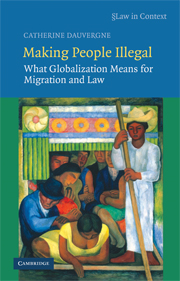Book contents
- Frontmatter
- Contents
- Acknowledgments
- Publication acknowledgments
- 1 Introduction
- 2 On being illegal
- 3 Migration in the globalization script
- 4 Making asylum illegal
- 5 Trafficking in hegemony
- 6 The less brave new world
- 7 Citizenship unhinged
- 8 Myths and Giants: The influence of the European Union and the United States
- 9 Sovereignty and the rule of law in global times
- Bibliography
- Index
- The Law in Context Series
1 - Introduction
Published online by Cambridge University Press: 05 June 2012
- Frontmatter
- Contents
- Acknowledgments
- Publication acknowledgments
- 1 Introduction
- 2 On being illegal
- 3 Migration in the globalization script
- 4 Making asylum illegal
- 5 Trafficking in hegemony
- 6 The less brave new world
- 7 Citizenship unhinged
- 8 Myths and Giants: The influence of the European Union and the United States
- 9 Sovereignty and the rule of law in global times
- Bibliography
- Index
- The Law in Context Series
Summary
In any given week in 2007, newspapers around the world carried reports of “illegal” migration. This did not start in 2007. It is not poised to end any time soon. While many of the accounts are about the United States or the European Union, unauthorized migration is newsworthy in all corners of the globe. Russia has a large and growing extralegal population. China stopped more than 2,000 illegal border crossers in 2006. Thailand and Malaysia have launched a cooperative approach to their shared illegal populations. The Gulf of Aden is a key human smuggling route. South Africa is attempting to grapple with its unauthorized occupants. Morocco and Ethiopia face similar issues. Brazil both sends and receives extralegal migrants, as does Mexico. Illegal migrants come in droves to India, and in lesser numbers to Pakistan. Whatever term we choose, extralegal migration is a global phenomenon.
The rise of the moral panic that accompanies this phenomenon is a marker of the twenty-first century. At the outset of the twentieth century, migration was in the process of becoming “legalized.” It was not until early in that century that a robust system of passports and visas was fully established to regulate border crossing. The great waves of migration of earlier eras took place largely without the framework of migration laws, fostered instead by the legal structures of colonial empires and the image of great unpopulated spheres of the globe.
- Type
- Chapter
- Information
- Making People IllegalWhat Globalization Means for Migration and Law, pp. 1 - 8Publisher: Cambridge University PressPrint publication year: 2008

